The Microsoft Surface Laptop 3 (15-Inch) Review: AMD Ryzen Surface Edition
by Brett Howse on October 21, 2019 9:00 AM EST- Posted in
- Laptops
- AMD
- Microsoft
- Surface
- Ryzen
- Surface Laptop
- Surface Laptop 3
Battery Life
Microsoft outfits all of the Surface Laptop 3 models with just a 46 Wh battery, which is actually slightly smaller than the one in the Surface Laptop 2, and all despite this 15-inch model being physically larger. Microsoft has also changed their battery testing methodology from a basic local video playback time, to a more realistic workload, so if you’re looking at the Microsoft spec pages, expect to see a lower runtime advertised as well.
The original Ryzen 2000 Raven Ridge platform had some serious power management issues, and this will be our first test of any Picasso based laptops, since AMD hasn’t had a lot of big design wins previous to this one for their second generation Ryzen APU.
Light Web

The 15-inch Surface Laptop 3 achieves just a touch under nine hours of runtime in our least-intensive battery test, with the display set to our standard of 200 nits brightness. While nine hours is a reasonable amount of time, it’s still well under the results from the smaller 13.5-inch Surface Laptop 2 we tested, which achieved almost 12 hours. That is a significant difference, of which some could likely be accounted by the larger display, which would inherently require more power to get to 200 nits, but it’s too big of a discrepancy to rest only on the display.
2016 Web
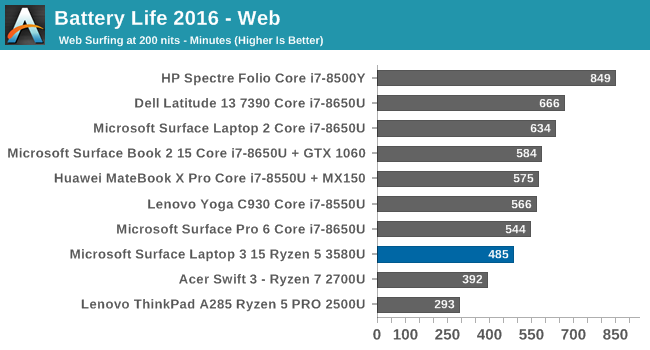
Our newer web test is much more CPU intensive, and a more realistic result than the older, lighter test. As expected, the results dropped further, to just over eight hours of usage, which is still a reasonable amount of time, but well under the 10.5 hours achieved by the Surface Laptop 2.
Movie Playback
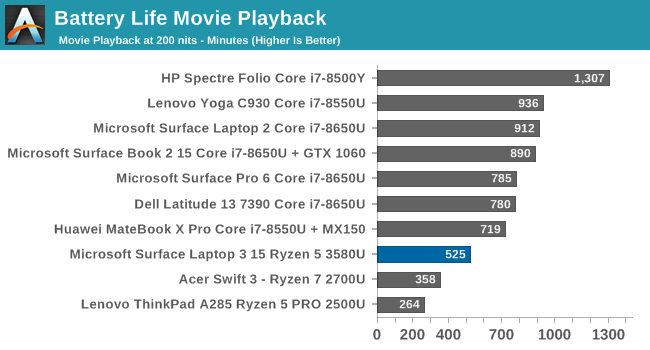
Video playback is one of Intel’s strengths, but it continues to be one of AMD’s weaknesses, with video playback time far shorter than the Intel offerings. Intel has put a lot of effort into offloading the video playback to fixed function hardware and turning the rest of the chip off, and while AMD certainly has hardware decode on their APU, it clearly can’t turn off the rest of the chip during playback, since the battery run time is somewhat less than our light web test.
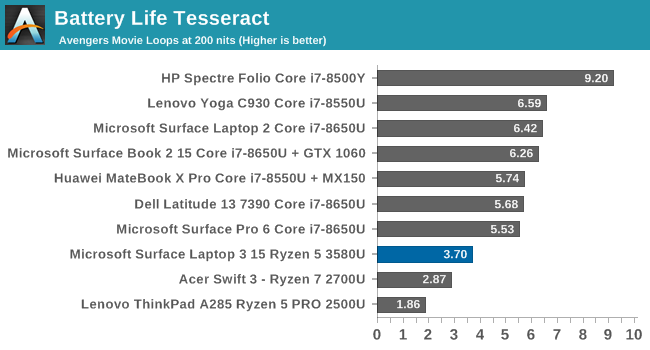
On the Tesseract score, the Surface Laptop 3 is still able to watch almost four entire sittings of The Avengers, which is a lot, but well under the 6.4 plays on the Surface Laptop 2.
Normalized Results
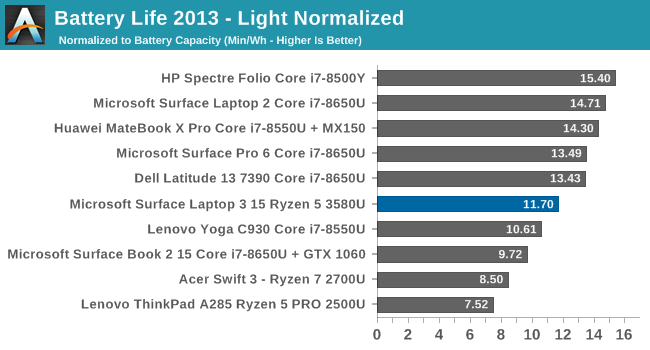
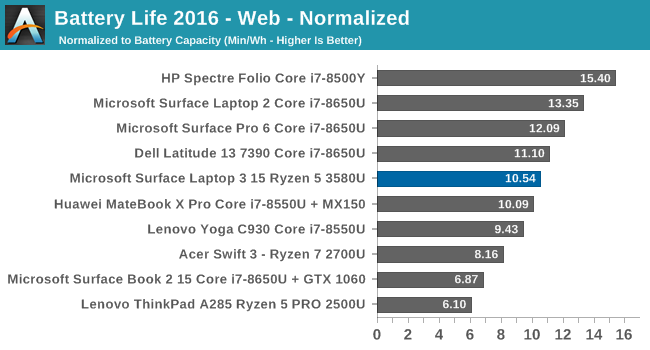
Removing the battery size from the runtimes lets us look at overall platform efficiency during the tests, and removes the insane runtime the Surface Book 2 provides thanks to its massive battery. Here the results are mixed. AMD has certainly made some tremendous strides in improving the abysmal platform power of the Ryzen APU from the original Raven Ridge to the current Picasso platform, with a much better showing in both the light test and 2016 Web results. Some of the discrepancy would come down to the display as well, since the larger 15-inch IGZO panel will need more power to light up to 200 nits than an equivalent 13.5-inch that we see in the Surface Laptop 2, but AMD definitely has more work to do in order to bring Ryzen's platform power down to what Intel has achieved.
The Acer Swift 3, which was the first Raven Ridge laptop we tested, drew 5.71 watts of power at idle with the display at 200 nits. That actually compares favorable with a Surface Book 2 15, which draws about the same – 5.53 Watts at idle with the display at 200 nits, but the main difference is the Surface Book 2’s display is the majority of the power draw thanks to its high resolution and 15-inch size. Removing display power from the devices results in the Acer Swift 3 drawing 4.55 watts at idle, and the Surface Book 2 drawing just 1.43 watts. The HP Spectre Folio, which features a Core i7 Y series processor, draws just 750 mW of power at idle.
The Surface Laptop 3 draws right around 5 Watts of power at idle with the display at 200 nits. That’s once again similar to the Surface Book 2 15, which draws 5.53 Watts. However, the Surface Laptop 3’s lower resolution display accounts for much less of the total platform draw. Removing the display from the equation results in the Surface Laptop 3 still drawing 2.35 Watts at idle. That’s significantly more than an Intel platform. So, while AMD has improved their battery draw tremendously, 2.35 Watts of idle power draw is still a lot and leads to the 15-inch Surface Laptop 3 delivering less battery life than the Surface Laptop 2, which was 8th generation Intel.
Charge Time
To make up for the less than amazing battery life of the Surface Laptop 3, Microsoft does include a stout 65-Watt charger which connects to the Surface Connect Port. All Surface power bricks also include an integrated USB-A output which is very handy when traveling if you need to charge your phone, although they may need to add USB-C soon.
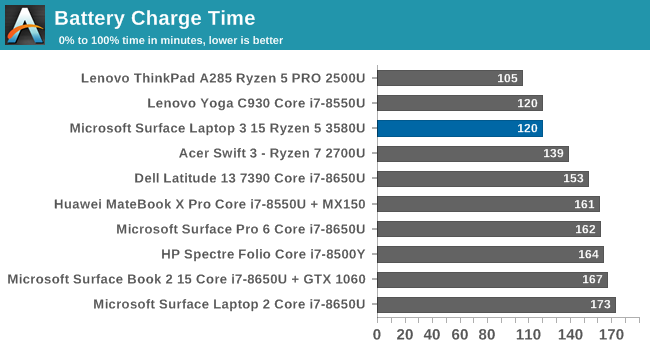
The Surface Laptop 3 charged very quickly. The smaller than average battery sized coupled with a larger than average adapter gave Microsoft lots of capacity to quickly get the Laptop 3 back up to a full charge.










91 Comments
View All Comments
isthisavailable - Monday, October 21, 2019 - link
*just a comment sh*tting on MS for still having 128gb ssd as the base storage*isthisavailable - Monday, October 21, 2019 - link
And charging $300 for 128gb more! Seriously are they using optane or what for justifying such insane pricing because I can buy a 2tb ssd for $300.andykins - Monday, October 21, 2019 - link
Couldn’t agree more with this. Even Apple doesn’t charge that much for an SSD upgrade. The base model is good value but shame about the prices of the upgrades.isthisavailable - Monday, October 21, 2019 - link
Apparently SSD is upgradable. Time to swap it with a 2tb monster.tipoo - Monday, October 21, 2019 - link
It's swappable, but it's a rare form factor within m.2 and currently there aren't many (any?) replacement drives in this form factor.sing_electric - Tuesday, October 22, 2019 - link
THIS x 10^3. Keeping a 128GB base was one thing 2 years ago when NAND prices were still through the roof, but today? And their prices to upgrade are even more insane.At LEAST there's a few replacement boards available (like this Toshiba - 512GB for a reasonable $160: https://www.newegg.com/p/1B4-0016-03F41?item=9SIAH...
Hifihedgehog - Monday, October 21, 2019 - link
Excellent review as always, Brett! Is the Surface Pro 7 also in the pipeline for a review here? I'm quite curious to see your analysis of the GPU performance.Brett Howse - Monday, October 21, 2019 - link
Sorry I didn't get sampled that yet. Next up will be the Ice Lake XPS 13 though so stay tuned.nandnandnand - Monday, October 21, 2019 - link
https://wccftech.com/amd-4th-3rd-gen-ryzen-ryzen-t...Throw it into the garbage.
Let's see 6, 8, 10, or even 12 cores.
outsideloop - Monday, October 21, 2019 - link
Ice Lake is two pieces of silicon. Intel 10nm yields are low. Ice Lake is expensive to make, and that gets passed onto laptop price. Yes, the Ryzen is $1200. The Ice Lake models will be closer to $2000. How much do you want to spend?